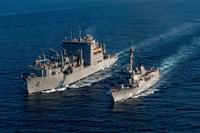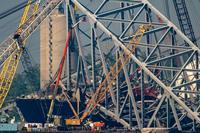 They may not be ready to punch holes in Decepticons, but the Navy is banking on electromagnetic railguns one day arming its newest ships.
They may not be ready to punch holes in Decepticons, but the Navy is banking on electromagnetic railguns one day arming its newest ships.
Directed energy weapons have created quite a buzz at this year’s Sea Air Space Expo at National Harbor, Md. They have always been a popular prop in science fiction movies; now the Navy is deploying the first directed energy “laser” weapon early next year aboard the amphibious transport dock Ponce.
While not as popular as lasers, high-energy rail guns are also generating plenty of excitement at this year’s show. The Navy has studied arming its new DDG 1000-class destroyer and Littoral Combat Ships with just such a weapon.
“There are feasible sizes of railguns we think we can put on these ships,” Robin White, director of Surface Ship Design and Systems Engineering, said Wednesday.
The Navy has spent the past eight years testing rail guns, most notably rolling out the first weaponized railgun in January 2012. The technology stands to offer additional range for land strikes as well as added capabilities in ballistic and cruise missile defense.
Railguns are capable of launching high-speed projectiles at targets out to 100 miles with out explosive propellants. They also can be guided on target, said Rear Adm. Matthew Klunder, chief of Naval Research and director of Innovation, Technology Requirements and Test & Evaluation.
These highly-advanced weapons, however, won’t come without challenges to overcome, White said. There will be power-storage issues to deal with as well as weight impacts for shipboard use. Heat dissipation and cooling will also have to be addressed.
“There will be many things to work through as we go forward, but the good news is these weapons provide tremendous advantage for shipboard use,” White said.
What type of shipboard use is still to be seen. Former Navy Under Secretary Robert Work said in January that he'd recommend delaying the decision on railguns until they Navy can decide how these weapons fit into the fleet design.
“Naval to naval exchanges just aren’t our thing right now. What it is is about projecting power in theaters where these land based anti-access aerial denial networks with guided weapons that can be thrown at range in salvos is a very, very difficult problem and the Navy is very focused on,” Work said in January.








